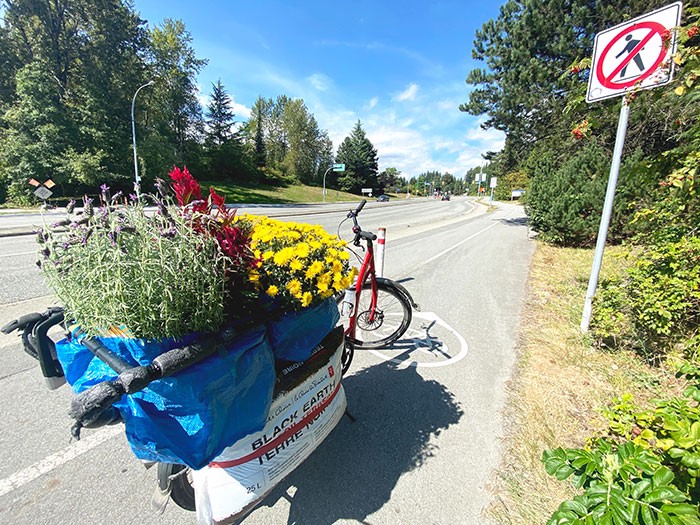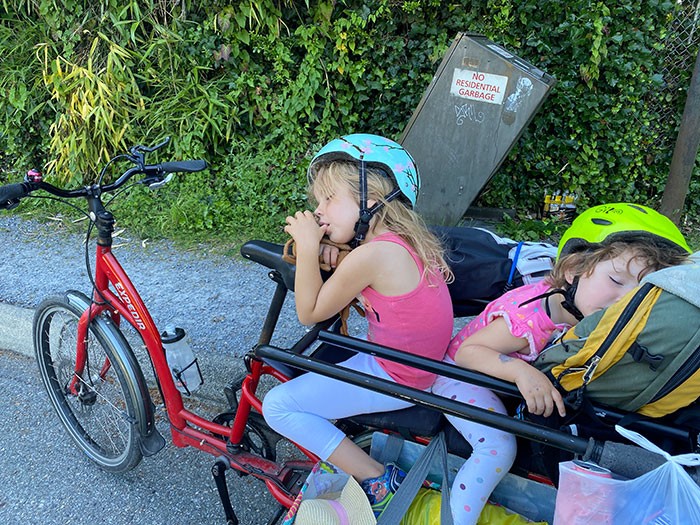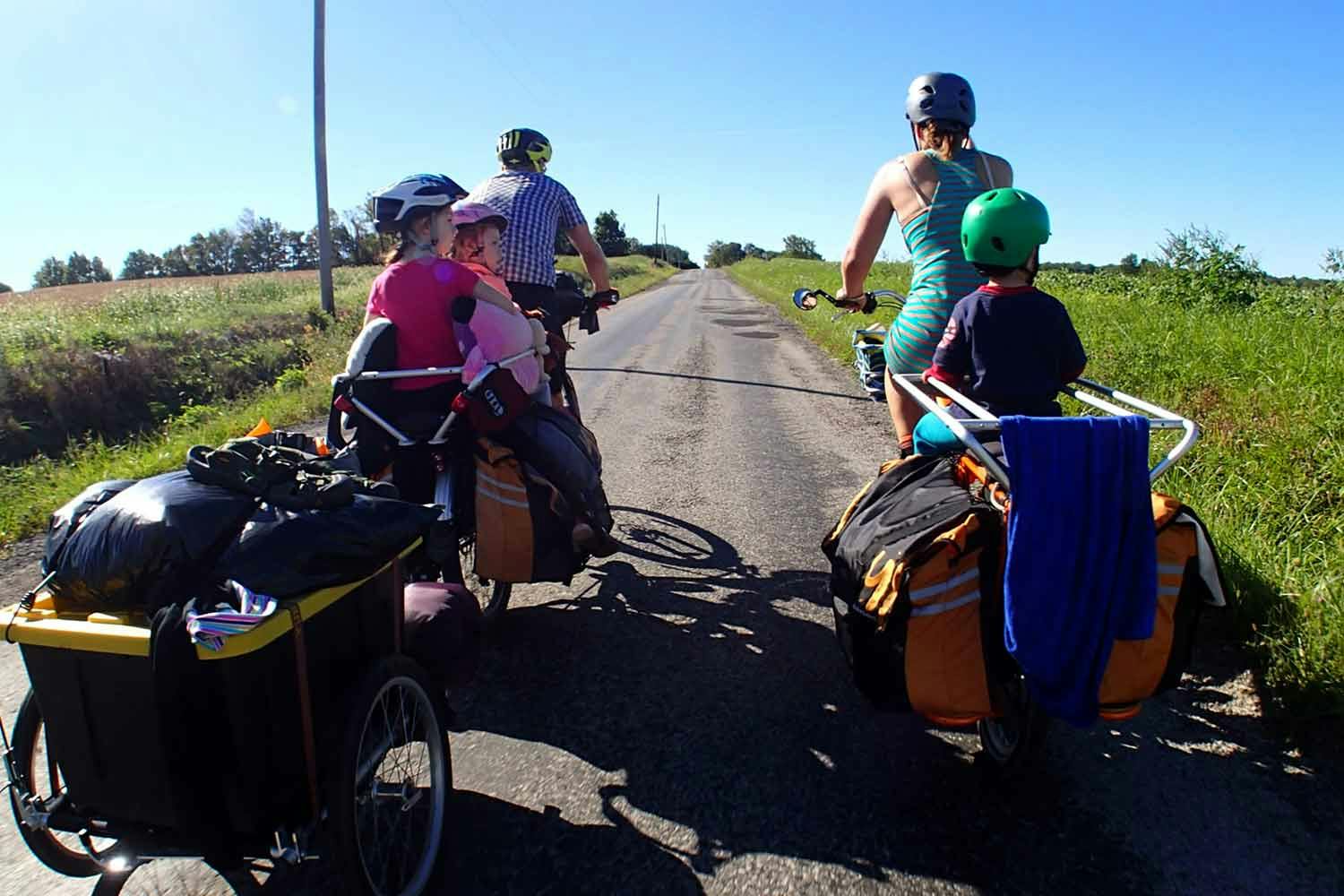Car-Free Parenting
A father of two shares the secrets to cargo-biking with kids.
As an on-again-off-again cyclist, I’ve always had a grudging admiration for those people who choose to ride everywhere, all of the time. I know people on Vancouver’s North Shore who ride to and from work — up to 25 kilometres away — every day, and even more that ride for fun and fitness. I can actually see myself commuting with rain gear and a briefcase, but what would happen if I also had a family to transport?
I asked North Vancouver District councillor Mathew Bond. When Bond’s daughter Wilhelmina was born, he didn’t rush out to buy a minivan: he decided to stick with his bright red 2016 Ezee Expedir cargo bike. When he became a father, Bond stepped back from his career as a transportation systems engineer for BC’s Ministry of Transport and became a stay-at-home dad. Because his work as a city councillor tends to be confined to evenings, he’s free during the day to parent.
Wilhelmina is now 6, with a 3-year-old sister named Coral. Bond still loads them onto the back of his bike and rides with them all over the hills and streets of North Vancouver.
A basic cargo bike like the Benno Carry On can be purchased for under US$1,500, but if you add extra carrying capacity and electric-assist, prices can quickly reach five times that number. So before you spend that much money, you really need to make sure it’s the right choice for you. Bond says he bought his cargo bike before they were all the rage, and he chose an electric version to take on the hills in his area.

Ask lots of questions
Bond cautions the curious to test ride these bikes before making a commitment. “My suggestion to people thinking about a cargo bike is to go borrow or rent one. Try it out, see what it’s like, even if it’s just for a day or just for a ride,” he says. “If you haven’t been biking in a long time, or you’re not a person that bikes regularly, try a little trip to the grocery store. I regularly put $300 worth of groceries on the bike. Carry some other things around before you carry your children around on it.”
Try it out, see what it’s like, even if it’s just for a ride.
But Bond’s biggest tip is a simple one: get advice from people already riding. In Vancouver, there are family biking Facebook pages, which include members that are taking their kids on cargo bikes. Social media offers a community that can answer questions about what type of bike will work best for each person’s circumstances. You can ask questions like: What kind of gear do you need, and where can you get it? Who has the best shops and the best services?
“And get a buddy and do a few rides… while they’re out and about on their cargo bike,” says Bond. “See where they go, what they do and how they do it. And ask them to come with you on your first few rides, or when you’re trying something like carrying a large load.”
Kid safety
If you’re planning on loading your kids onto the bike, you have a whole new set of concerns, according to Bond. First off, is helmet safety: “You have to wait till your child’s head fits a helmet.”
Bond started each of his girls riding up front in a seat between his arms. When Bond’s youngest, Coral, started riding, he added a second seat on the back of the bike for Wilhelmina. Eventually both Bond’s girls wound up riding on the rear carrier. If you’ve got two small people on the back of a bike, face them away from one another so they don’t knock helmets.

Learn your bike and your hood
The father of two also has some advice for those in the driver’s seat. “Make sure you’re comfortable. Build up your confidence, and learn your routes,” he says. “Take your kids on a ride in the park, somewhere safe, and then kind of build up from there.” He’s also the former president of the North Shore Mountain Bike Association and believes that cycling with his girls gives them a better understanding of their hometown. While most kids travel in a rear-facing car seat, his girls are riding along with him.
“Kids have a lot less freedom nowadays,” says Bond. “Because they get driven around, they don’t even understand their own neighbourhood. I think developing that kind of sense of place is important.”
As well as helping his daughters to map out their own hometown, the bike trips build confidence and knowledge in his daughters. “The girls know how to get to Lynn Valley, or their friend’s house. Wilhelmina can give me directions: ‘Okay, it’s this way. And let’s go here; let’s go there. Remember when we saw that animal here?’”
Consider storage options
Bond’s final piece of cargo-bike advice is to think carefully about storage. If you live in a condo or apartment, or if you have to navigate a small elevator, what are the best places to park and lock your bike? And if it’s electric, where can you plug in to charge it?
Bond has a parking space with a regular electrical outlet, but had to ask his strata for permission. And then they had to figure out how much to charge him.
After years of riding everywhere on a cargo bike, juggling kids, and home, and council work, Bond is happy with his choices. “When I tell people I use it for almost all my everyday trips, many are stunned, but also excited, and ask ‘Well, how do you . . . ?’”
When I tell people I use it for almost all my everyday trips, many are stunned, but also excited.
Growing up on the back of a cargo bike has one more important benefit for Bond’s daughters. It’s no surprise that Wilhelmina is proud that she can now ride on her own.
“I already knew how to pedal when I was 4,” she says. “I practised and practised… I first started with no pedals. Then I said, ‘I have enough balance Papa.’ Then I tried the pedals.”
And when asked if she had ever fallen: “Yeah. But not too hard.”
Print Issue: Spring/Summer 2021
Print Title: Precious Cargo
